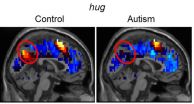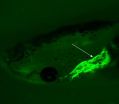(Press-News.org) PITTSBURGH--Psychiatric disorders -- including autism -- are characterized and diagnosed based on a clinical assessment of verbal and physical behavior. However, brain imaging and cognitive neuroscience are poised to provide a powerful advanced new tool.
Carnegie Mellon University researchers have created brain-reading techniques to use neural representations of social thoughts to predict autism diagnoses with 97 percent accuracy. This establishes the first biologically based diagnostic tool that measures a person's thoughts to detect the disorder that affects many children and adults worldwide.
Published in PLoS One, the study combined functional magnetic resonance imaging (fMRI) and machine-learning techniques first developed at Carnegie Mellon that use brain activation patterns to scan and decode the contents of a person's thoughts of objects or emotions. The previous work also demonstrated that specific thoughts and emotions have a very similar neural signature across normal individuals, suggesting that brain disorders may display detectable alterations in thought activation patterns.
Now, the research team led by CMU's Marcel Just has successfully used this approach to identify autism by detecting changes in the way certain concepts are represented in the brains of autistic individuals. They call these alterations "thought-markers" because they indicate abnormalities in the brain representations of certain thoughts that are diagnostic of the disorder.
"We found that we could tell whether a person has autism or not by the their brain activation patterns when they think about social concepts. This gives us a whole new perspective to understanding psychiatric illnesses and disorders," said Just, the D. O. Hebb University Professor of Psychology in the Dietrich College of Humanities and Social Sciences and a leading researcher into the neural basis of autism. "We've shown not just that the brains of people with autism may be different, or that their activation is different, but that the way social thoughts are formed is different. We have discovered a biological thought-marker for autism."
For the study, Just and his colleagues scanned the brains of 17 adults with high-functioning autism and 17 neurotypical control participants. The participants were asked to think about 16 different social interactions, such as "persuade," "adore" and "hug."
The resulting brain images showed that the control participants' thoughts of social interaction clearly included activation indicating a representation of the "self," manifested in the brain's posterior midline regions. However, the self-related activation was near absent in the autism group. Machine-learning algorithms classified individuals as autistic or non-autistic with 97 percent accuracy based on the fMRI thought-markers.
"When asked to think about persuading, hugging or adoring, the neurotypical participants put themselves into the thoughts; they were part of the interaction. For those with autism, the thought was more like considering a dictionary definition or watching a play - without self-involvement," Just said.
Implications of this research could extend to other psychiatric disorders, such as being suicidal or having obsessive-compulsive disorder, in which certain types of thoughts are altered. By providing a brain-based measure of the altered thoughts to use in conjunction with clinical assessments, this new research could enable clinicians to make quicker and more certain diagnoses and more quickly implement targeted therapies that focus on the alteration.
"This is a potentially extremely valuable method that could not only complement current psychiatric assessment. It could identify psychiatric disorders not just by their symptoms but by the brain systems that are not functioning properly. It may eventually be possible to screen for psychiatric disorders using quantitative biological measures of thought that would test for a range of illnesses or disorders," Just said.
This neuroscience research is on the vanguard of two fronts: it advances the scientific mission of classifying and diagnosing mental disorders based on behavioral and neurobiological measures (rather than conventional symptoms), and it integrates the conception of brain and mind by assessing thoughts in terms of brain function.
For more information about how brain representations of social thoughts accurately predict autism diagnosis, watch Just discuss the research at http://youtu.be/G1rl-K3LD9c.
INFORMATION:
In addition to Just, the research team included CMU's Vladimir L. Cherkassky, Augusto Buchweitz, Timothy A. Keller and Tom M. Mitchell.
The National Institute of Mental Health funded this research.
As the birthplace of artificial intelligence and cognitive psychology, Carnegie Mellon has been a leader in the study of brain and behavior for more than 50 years. The university has created some of the first cognitive tutors, helped to develop the Jeopardy-winning Watson, founded a groundbreaking doctoral program in neural computation, and completed cutting-edge work in understanding the genetics of autism. Building on its strengths in biology, computer science, psychology, statistics and engineering, CMU recently launched BrainHubSM, a global initiative that focuses on how the structure and activity of the brain give rise to complex behaviors.
People could be putting their lives at risk by dismissing potential warning signs of cancer as less serious symptoms, according to a Cancer Research UK-funded study* published in PLOS ONE today (Tuesday).
More than half (53 per cent) of 1,700** people who completed a health questionnaire said they had experienced at least one red-flag cancer 'alarm' symptom during the previous three months***. But only two per cent of them thought that cancer was a possible cause.
Researchers sent the questionnaire listing 17 symptoms**** - including 10 widely-publicised potential cancer ...
LIMA--(2 December 2014) A new peer-reviewed study, released today at the start of the UN climate conference in Peru, reveals the unprecedented amount of carbon stored within the nine-nation network of Amazonian indigenous territories and protected natural areas. Accepted for publication in Carbon Management, the paper entitled, "Forest Carbon in Amazonia: The Unrecognized Contributions of Indigenous Territories and Protected Natural Areas," suggests that protecting the vast amount of carbon stored above ground in the forests of indigenous and protected lands - totaling ...
COLUMBIA, Mo. - According to a recent report from the Federal Reserve Board, 31 percent of Americans surveyed said they had no retirement savings, and almost half were not actively thinking about planning for retirement. Studies show that many Americans do not invest because they distrust the market and fear financial losses. Now, a University of Missouri researcher has found a way for financial planners to help decrease their clients' worries, which stem from the fear of losing money.
Michael Guillemette, an assistant professor in the MU College of Human Environmental ...
EAST LANSING, Mich. - To hunt or not hunt wolves can't be quantified as simply as men vs. women, hunters vs. anti-hunters, Democrats vs. Republicans or city vs. rural.
What's truly fueling the divisive debate is fear of wolves or the urge to care for canis lupis. The social dynamics at play and potential options for establishing common ground between sides can be found in the current issue of the journal PLOS ONE.
"People who are for or against this issue are often cast into traditional lots, such as gender, political party or where they live," said Meredith Gore, associate ...
Using a novel gene knock-in technique, effective insertion of an exogenous gene was demonstrated in human cells and in animal models, including silkworms and frogs. This strategy universally enables gene knock-in not only in cultured cells, but also in various organisms.
Genome editing using programmable nucleases enables homologous recombination (HR)-mediated gene knock-in. HR activity, however, is relatively low in most cultured cells and organisms. This problem presents technical hurdles for the application of HR-mediated knock-in technology in the field of life sciences. ...
RICHLAND, Wash. - A new study will help researchers create longer-lasting, higher-capacity lithium rechargeable batteries, which are commonly used in consumer electronics. In a study published in the journal ACS Nano, researchers showed how a coating that makes high capacity silicon electrodes more durable could lead to a replacement for lower-capacity graphite electrodes.
"Understanding how the coating works gives us an indication of the direction we need to move in to overcome the problems with silicon electrodes," said materials scientist Chongmin Wang of the Department ...
HANOVER, N.H. - Logging doesn't immediately jettison carbon stored in a forest's mineral soils into the atmosphere but triggers a gradual release that may contribute to climate change over decades, a Dartmouth College study finds.
The results are the first evidence of a regional trend of lower carbon pools in soils of harvested hardwood forests compared to mature or pristine hardwood forests. The findings appear in the journal Global Change Biology Bioenergy. A PDF of the study is available on request.
Despite scientists' growing appreciation for soil's role in the ...
PULLMAN, Wash. - More than one-third of new commercial building space includes energy-saving features, but without training or an operator's manual many occupants are in the dark about how to use them.
Julia Day recently published a paper in Building and Environment showing for the first time that occupants who had effective training in using the features of their high-performance buildings were more satisfied with their work environments. Day did the work as a doctoral student at Washington State University; she is now an assistant professor at Kansas State University.
Closed ...
TORONTO, ON - Scientists have long known that air pollution caused by cars and trucks, solvent use and even plants, is reduced when broken down by naturally occurring compounds that act like detergents of the atmosphere. What has not been well understood until now are the relative contributions of all the processes producing such compounds.
A new study, led by University of Toronto atmospheric chemist Jennifer Murphy, shows a key component of the process is the soil beneath our feet.
"Pollutants in the atmosphere are broken down by hydroxyl radicals that are produced ...
This news release is available in German.
VIDEO:
Scientists decode the three-dimensional structure of the calcium channel with unprecedented accuracy.
Click here for more information.
Whenever muscles contract, so-called ryanodine receptors come into play. Calcium ions, which are ultimately responsible for the contraction of muscle cells, are released from storage organs and flow ...




